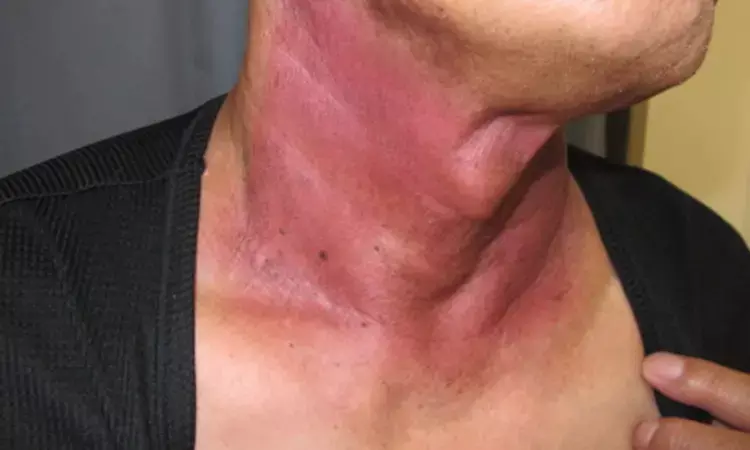- Home
- Medical news & Guidelines
- Anesthesiology
- Cardiology and CTVS
- Critical Care
- Dentistry
- Dermatology
- Diabetes and Endocrinology
- ENT
- Gastroenterology
- Medicine
- Nephrology
- Neurology
- Obstretics-Gynaecology
- Oncology
- Ophthalmology
- Orthopaedics
- Pediatrics-Neonatology
- Psychiatry
- Pulmonology
- Radiology
- Surgery
- Urology
- Laboratory Medicine
- Diet
- Nursing
- Paramedical
- Physiotherapy
- Health news
- Fact Check
- Bone Health Fact Check
- Brain Health Fact Check
- Cancer Related Fact Check
- Child Care Fact Check
- Dental and oral health fact check
- Diabetes and metabolic health fact check
- Diet and Nutrition Fact Check
- Eye and ENT Care Fact Check
- Fitness fact check
- Gut health fact check
- Heart health fact check
- Kidney health fact check
- Medical education fact check
- Men's health fact check
- Respiratory fact check
- Skin and hair care fact check
- Vaccine and Immunization fact check
- Women's health fact check
- AYUSH
- State News
- Andaman and Nicobar Islands
- Andhra Pradesh
- Arunachal Pradesh
- Assam
- Bihar
- Chandigarh
- Chattisgarh
- Dadra and Nagar Haveli
- Daman and Diu
- Delhi
- Goa
- Gujarat
- Haryana
- Himachal Pradesh
- Jammu & Kashmir
- Jharkhand
- Karnataka
- Kerala
- Ladakh
- Lakshadweep
- Madhya Pradesh
- Maharashtra
- Manipur
- Meghalaya
- Mizoram
- Nagaland
- Odisha
- Puducherry
- Punjab
- Rajasthan
- Sikkim
- Tamil Nadu
- Telangana
- Tripura
- Uttar Pradesh
- Uttrakhand
- West Bengal
- Medical Education
- Industry
Proton beam therapy-induced ADR can be treated effectively by topical corticosteroids: Study

Taiwan: A new study found that in patients with nasopharyngeal carcinoma (NPC), acute radiation dermatitis (ARD) induced by proton beam therapy (PBT) can be treated effectively by topical corticosteroid, silver sulfadiazine, and non-adhering silicone dressing. The article was published in the International Wound Journal.
Nasopharyngeal cancer (NPC) is a rare and geographically unique, squamous epithelial carcinoma occurring in the mucosal wall of the nasopharynx. Radiotherapy (RT) with or without the combination of chemotherapy is the major treatment for NPC. Proton beam therapy (PBT) is an advanced form of radiotherapy, with radiation treatment delivered by accelerated proton beams rather than X-rays. In recent years, PBT has been embraced for treating patients with NPC. However, Some studies have reported a high incidence of severe ARD for cancer patients treated with PBT.
Ko-Chun Fang, Kaohsiung Chang-Gung Memorial Hospital and Chang Gung University College of Medicine, Taiwan and colleagues initiated an observational study to investigate the prognostic factors and treatment outcomes of ARD among patients with NPC treated with PBT.
Researchers enrolled 57 patients with newly diagnosed NPC and were treated with PBT for the study. ARD was recorded weekly based on the criteria of Common Terminology Criteria for Adverse Events version 4.0 at treatment visits (1st to 7th weeks) and 1 week (8th week) and 1 month (11th week) after the completion of PBT. Topical corticosteroid was used when grade 1 ARD appeared, and silver sulfadiazine was added if ARD progressed to grade 2 or more. Non-adhering silicone dressing was applied over the cream, but only in the area with severe ARD.
Key findings of the study,
• The maximum ARD grade was 1, 2, and 3 in 45.6%, 42.1% and 12.3% of the patients, respectively.
• The peak incidence of grade 2 and 3 ARD was observed during the period of the 6th to 8th weeks.
• In 42.1% of the patients, ARD was treated with topical corticosteroid alone, 57.9% of the patients applied topical corticosteroid plus silver sulfadiazine and 43.8% of patients required non-adhering silicone dressing to cover severe skin wound area.
• In the 11th week, most grade 2 and 3 ARD had disappeared and 93.0% of the patients had ARD of grade 1 or lower.
• In the binary logistic regression model, habitual smoking and N2 to N3 nodal status were identified as independent predictors of grade 2 and 3 ARD.
Based on their observation, the authors conclude that ARD is a major concern for patients with NPC treated with PBT, especially those with a smoking habit or advanced nodal status and topical corticosteroids, silver sulfadiazine, and non-adhering silicone dressing are effective for treating these PBT-induced ARD induced.
Reference:
Ko-Chun Fang,Chih-Hung Lee,Hui-Ching Chuang,Tai-Lin Huang,Chih-Yen Chien,Wen-Ling Tsai,Fu-Min Fang. First published: 26 July 2022 https://doi.org/10.1111/iwj.13897
BDS
Dr. Hiral patel (BDS) has completed BDS from Gujarat University, Baroda. She has worked in private dental steup for 8years and is currently a consulting general dentist in mumbai. She has recently completed her advanced PG diploma in clinical research and pharmacovigilance. She is passionate about writing and loves to read, analyses and write informative medical content for readers. She can be contacted at editorial@medicaldialogues.in.
Dr Kamal Kant Kohli-MBBS, DTCD- a chest specialist with more than 30 years of practice and a flair for writing clinical articles, Dr Kamal Kant Kohli joined Medical Dialogues as a Chief Editor of Medical News. Besides writing articles, as an editor, he proofreads and verifies all the medical content published on Medical Dialogues including those coming from journals, studies,medical conferences,guidelines etc. Email: drkohli@medicaldialogues.in. Contact no. 011-43720751


